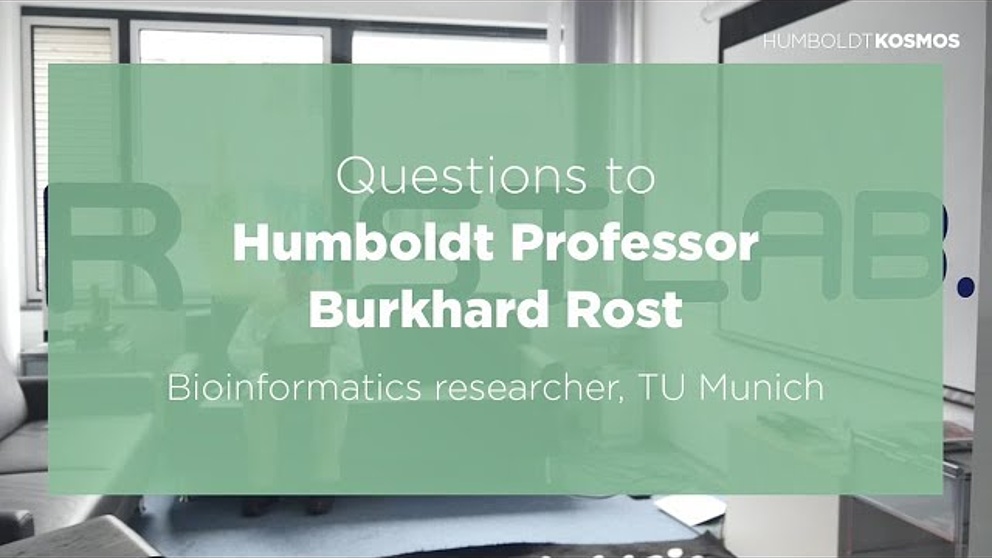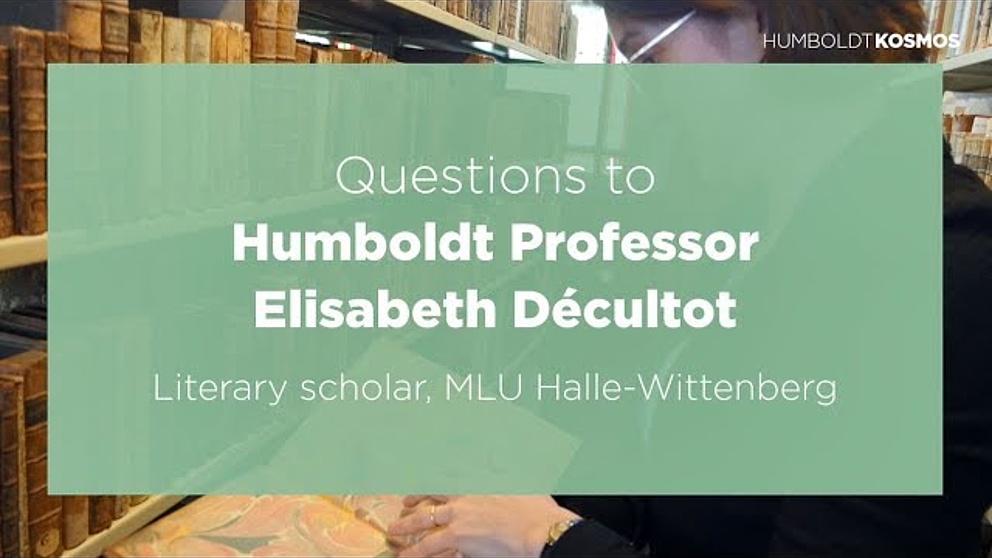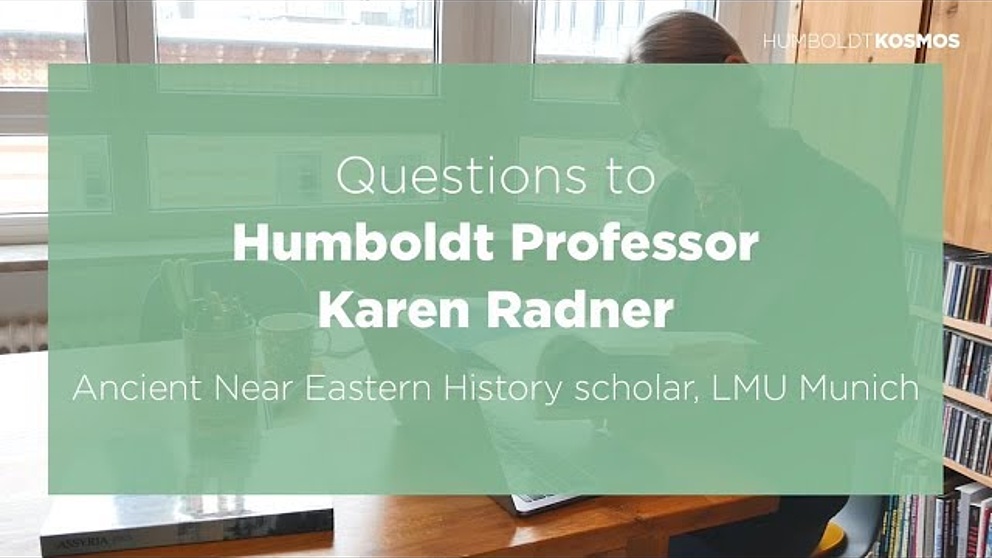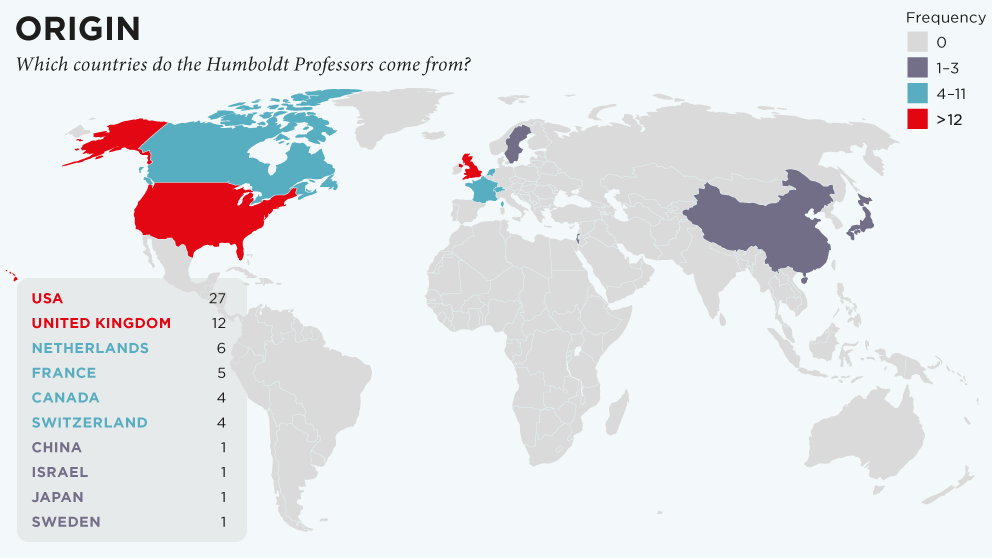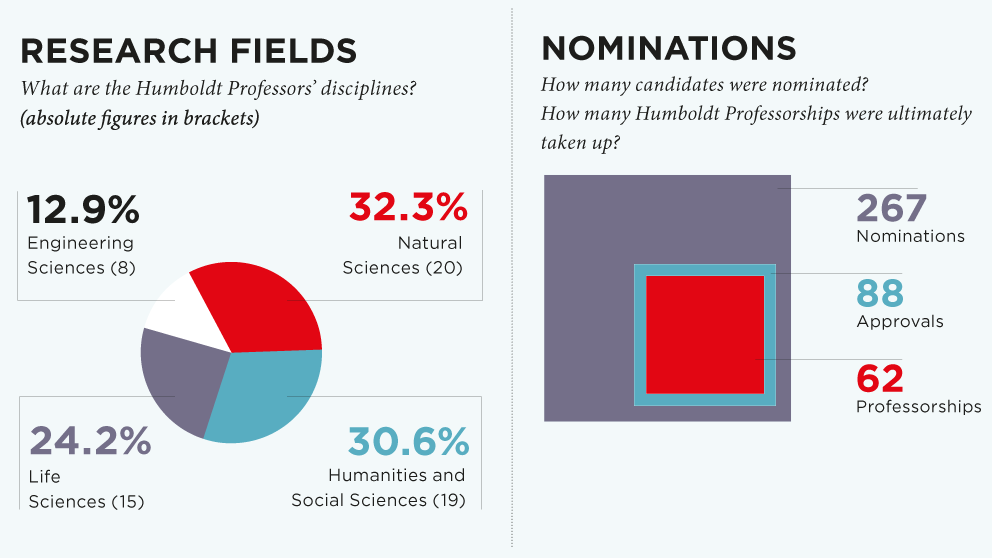Jump to the content
- {{#headlines}}
- {{title}} {{/headlines}}

The Humboldt Professorship in keywords
Official name: Alexander von Humboldt Professorship – International Award for Research in Germany
Launched: 2008
Scope: up to 10 professorships per year, sponsorship for 5 years
Endowment: 3.5 million euros for researchers in theoretical disciplines, 5 million euros for experimental researchers
Funded by: Federal Ministry of Education and Research
Website: Dossier Alexander von Humboldt Professorship

At the start, says Oliver Brock, all the public attention took a bit of getting used to. “An enormous fuss was made of us, I was even on national news,” the computer scientist explains. That was ten years ago when Brock – thanks to his name starting with a B – was the first ever Alexander von Humboldt Professor to be appointed.
Up to then, there had certainly never been such an attractively endowed research award in Germany: up to five million euros award money for five years that can be used flexibly, whether to build a research team or for conferences, technical equipment or even for dual career measures for accompanying partners. And on top of all this: the prospect of a permanent association with the respective German university that does not stop at the end of the funding period, and an almost tailormade working environment. The aim of this opportunity is to persuade researchers working abroad to continue their careers in Germany. In 2008, the first cohort of Humboldt Professors was selected, assuming their professorships in 2009. And the target group for the award, which is granted by the Alexander von Humboldt Foundation and financed by the Federal Ministry of Education and Research, are international luminaries in their respective research fields.
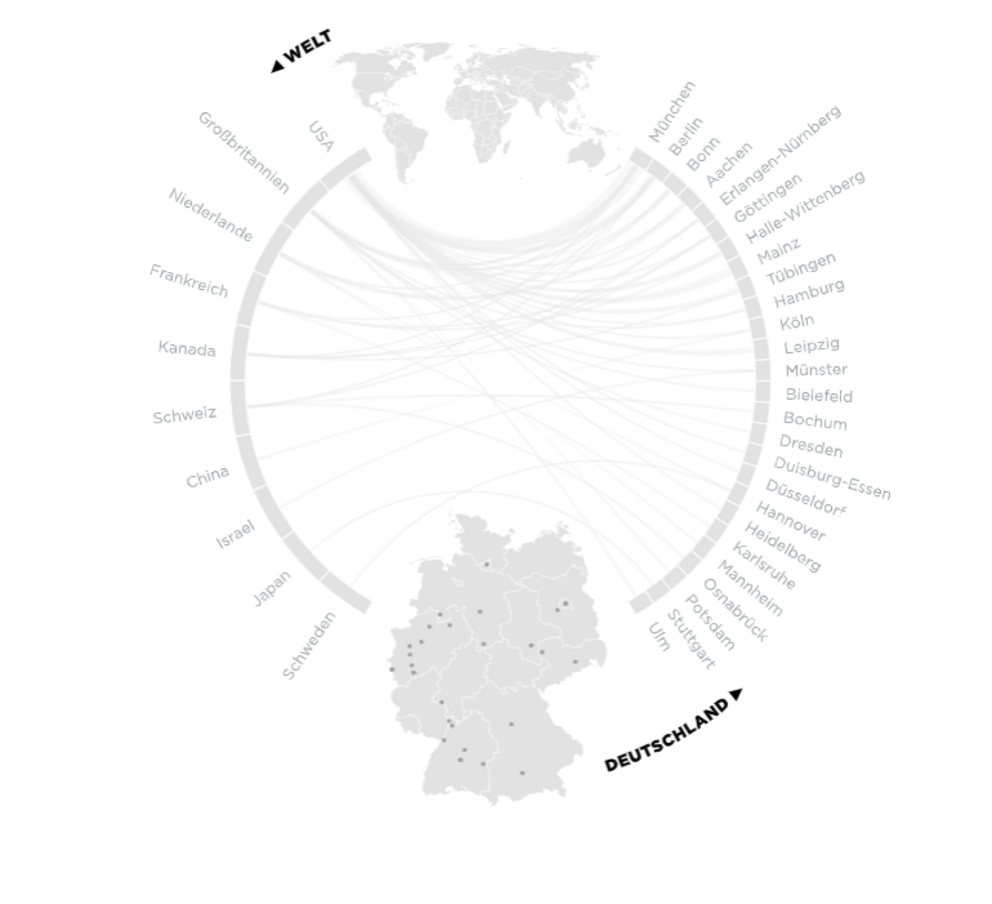
Rock stars of research
If you consider that a Nobel Prize is worth roughly a million euros, it is immediately obvious why the first Humboldt Professorships caused such a furore a decade ago. “For a while, we were treated like rock stars,” says Oliver Brock, laughing, and adds, “Luckily, things calmed down again quite soon.” Because Brock and the other award winners had not come to Germany to be celebrated, but to conduct research. To date, 62 professors have relocated to German universities (as of April 2018). They have triggered changes in German science culture in many areas, according to an evaluation that has recently been completed. The goal from the very beginning was, after all, not just to attract the stars of international research but also to utilise their engagement and experience to inject some movement into what is sometimes a rather sluggish system of higher education in Germany.
“What was new about this tool, and still is, was linking personnel aspects to universities’ structural aspects,” says Peter Strohschneider, President of the German Research Foundation (DFG). “In some cases, the results were downright spectacular.” As a member of the selection committee, Strohschneider has followed the fate of the Humboldt Professorship for many years and cites as examples Mathematical Philosophy in Munich, Mediaeval Jewish Art History in Münster and Experimental Physics in Halle. “The Humboldt Professorship combines a massive impact with an extremely economical use of resources,” says Peter Strohschneider. When he talks about the programme, the DFG President, who is also the ex officio Vice President of the Alexander von Humboldt Foundation, waxes positively lyrical – about the “rigid quality standards”, the “uncompromising funding” and the “high efficiency” of the award.
Shaking up the inner life of the unis
Top international researchers, in the shape of the Humboldt Professors, who have experienced a different scientific socialisation are intentionally supposed to shake up the inner life of German universities, whilst at the same time having to tread new ground themselves. When different cultures meet, they break open ossified structures: that is one of the intended side effects of this research award. And, indeed, despite the internationality of academic life, there are certain hurdles that nearly all Humboldt Professors have encountered. “When you come from abroad, it’s pretty difficult to penetrate the rigid pay scale system in German science,” notes the Ancient Near Eastern History specialist Karen Radner. Since 2015, she has held a Humboldt Professorship at LMU in Munich. Although she was already familiar with the Bavarian capital and its universities, the various salary scales in Germany’s federal states’ collective agreement were a challenge when she relocated from London.
An experience shared by Elisabeth Décultot. The French literary scholar moved from Paris to Halle in 2015. She had already worked in Berlin for three years and is married to a German Germanist. “Inspite of that, it was a big leap, because there is a gulf between the science culture in France and Germany,” she says, “and I had a lot to learn, particularly with regard to collective agreements and how to deal with German university administration.” Without the support of her staff, she would not have managed so well, says Décultot. In particular, Germany’s penchant for fixed-term contracts was new to her. In the meantime, she has learned how to handle the system and even appreciates some of its advantages. “The research group benefits from new faces and approaches.” The downside was a certain instability and, not least, her concern about what would happen to her staff when their contracts ran out. All in all, however, the Humboldt Professorship was an incredibly attractive offer in Elisabeth Décultot’s eyes.
Nearly all the previous award winners share this assessment. The Humboldt Foundation recently contracted external evaluators to examine the programme. They considered the period from 2008 to 2015. The results of the evaluation clearly show that due to the high degree of flexibility in the use of funds, the clear focus, efficient management and well-balanced scope of the budget and sponsorship period, the Alexander von Humboldt Professorship develops and strengthens internationality and top scientific research at research institutions in Germany. “The programme helps to recruit established stars on the international research firmament.” The award winners were often leading actors in developing structures across universities’ classic faculty-based organisation – an indication that the traditional boundaries between disciplines are being broken down whilst new, interdisciplinary networks are emerging. The Humboldt Professorship had thus also become a symbol of renewal and interdisciplinarity, the study concludes.

Women are in demand
In 2013, an interim evaluation was conducted after the first five years of the programme. It, too, was basically positive, but also revealed certain latent systemic problems: at the time, Enno Aufderheide, the Secretary General of the Alexander von Humboldt Foundation, expressed “genuine concern” about the low percentage of women nominated and appointed. Amongst the seven award winners who were originally selected in 2008, the first year of the programme, and who assumed their Humboldt Professorships the following year there was, at least, one woman. After that, however, it took four long years before the next female Humboldt Professor could be recruited. Since then, the proportion of women has varied from year to year. One year it was 80 per cent, another 43 per cent. These big fluctuations also stem from the small number of professorships in total. Even so, the current evaluation report notes that the situation has improved significantly since 2013. Looking at the figures for appointments since then, the proportion of women has been 45 per cent; from 2008 to 2012, it was three per cent. This upturn was partly due to the Foundation’s intensive mobilisation efforts. Universities were informed, for example, that nominations on behalf of excellent female researchers would be expressly welcomed.
In this context, the bioinformatics researcher Burkhard Rost has observed that somewhat antiquated gender perceptions are still sometimes to be found in Germany, not least with regard to the Professors’ partners. Like Oliver Brock, Rost is a first-generation Humboldt Professor, having moved to TUM Munich from Columbia University in New York in 2009. Initially, his wife, who had been a professor at an American Ivy League university was only offered a postdoctoral position in Germany. “The Foundation then made sure she got a suitable appointment,” says Rost.
Despite the general positive trend, Sharon Macdonald also thinks it is “disturbing” that so few of the Humboldt Professors are women. An ethnologist, she herself came to Berlin’s Humboldt-Universität from the UK in 2015. “It was a pre-Brexit decision – although I’m now definitely pleased to be here,” says Macdonald. She had been intrigued by the opportunity of building a large research group. “It’s an enormous privilege and simply brilliant!” Berlin was an extremely good location for her because of the many museums and cultural institutions “and because of the other amazing researchers who work here”. But the eminent British researcher also experienced things that made her thoughtful – such as the question as to whether or not it was possible to pay for her research group’s desk lamps from the award money. “Humboldt-Universität has a lot of rules,” says Sharon Macdonald with slight understatement. “It’s such a waste of time if you have to enter into negotiations on things like your desk lamp.” After all, she had come here to do research, as quickly and as intensively as possible.
The competition never ceases
It can, however, be precisely such trivialities that determine whether a funding measure is successful. It is not for nothing that the top researchers who are the target of the Humboldt Professorship can usually bet on excellent working conditions elsewhere as well. Their universities therefore face tough and permanent competition. And it is a contest that can be lost, as Hannover Medical School and the Helmholtz Centre for Infection Research in Braunschweig learned to their cost. In 2014, they had jointly appointed the French microbiologist and biochemist Emmanuelle Charpentier to a Humboldt Professorship. But just one year later, Charpentier moved on to become director of the Max Planck Institute for Infection Biology in Berlin. Even the good general conditions of the Humboldt Professorship could not hold her back. And in 2018, Charpentier, who is seen as a candidate for a Nobel Prize for her discovery of the much-discussed genetic scissors, will assume another position, becoming the head of the Max Planck Unit for the Science of Pathogens in Berlin. Only in very few cases, however, did the sponsorship find an early end: up to now, including Charpentier, just three of the 62 Humboldt Professors have broken off their awards.
Horst Hippler, President of the German Rectors’ Conference (HRK), believes the Humboldt Professorship is a highly attractive way for universities to recruit top-level personnel. “The award winners bring along international networks in a research area of strategic importance to the university,” says Hippler. “Moreover, professorships can be proposed jointly with another university or non-university research institution which further promotes networking with partners in the region.” Although it would be even better, according to the HRK President, if the sponsorship period could be extended beyond the current period of five years to make the tool yet more attractive.

The one aspect of the programme begging particular improvement was identified in the course of the evaluation as the transition phase immediately following sponsorship when the award winners continue their research at their universities as regular professors without additional funding. Many of those surveyed reported on tangible difficulties. Seven Humboldt Professors whose Humboldt sponsorship had come to an end took part in the survey for the evaluation. Two reported that their personnel and infrastructural resources were very significantly reduced when the funding from the Foundation stopped flowing. Four others reported that their resources had since become somewhat scarcer. Only in one case was the volume of funding the same before and after the five-year sponsorship period. “In the transition phase, some of the professors encountered difficulties getting hold of the funding that had been informally agreed when they first assumed their professorships,” the study summarises.
When it comes to agreements, reliability pays off, as the examples of Oliver Brock and Burkhard Rost demonstrate. Both are still doing their research in Berlin and Munich respectively although the funding associated with their Humboldt Professorships has come to an end. And despite the criticisms of the transition phase, overall it has largely been possible to retain the award winners after the sponsorship period. With three exceptions, in April 2018, all 27 Humboldt Professors who were no longer receiving sponsorship were still in Germany.
Another key message from the evaluation was that the professors’ experiences and successes should be communicated more strategically: the “potential for critical thinking” that was essentially shaped by their international experience should be used for feedback within the German research landscape. At the same time, the core features of the Humboldt Professorship – freedom and flexibility – should be documented more robustly and communicated externally because in the form made possible by the Humboldt Professorship they are “extremely rare”. Burkhard Rost also feels that more of a voice should be given to “the colour the Humboldt Professors lend to the science landscape”. He suggests increasing the award winners’ networking amongst themselves “to live out interdisciplinarity and tell people about it”. And to show others that something really is happening in the German science system.

Money for quality only
A glance at the history of the Humboldt Professorships to date, however, also reveals that the selection committee does not always award all ten Professorships every year – a clear indication, according to DFG President Peter Strohschneider, that it “really is a tool for top-level research”. Even if there are sufficient resources to fund more awards, the Humboldt Professorship is only granted when the quality of the nominees is truly outstanding. Referring to his experience on the selection committee, Strohschneider comments, “The work is such fun.” This was partly because of the high quality of the proposals, partly because of the colleagues on the committee: “We have such free and openminded discussions. And the fact that a disproportionately large number of small subjects is successful just makes it all the more interesting.”
Oliver Brock’s assessment is unequivocal: “This programme is simply wonderful.” The freedom of thought it had allowed him was something “like breaking the intellectual sound barrier”. In that respect, he thought the programme “was one of the best things that could have happened to the German science landscape”.

